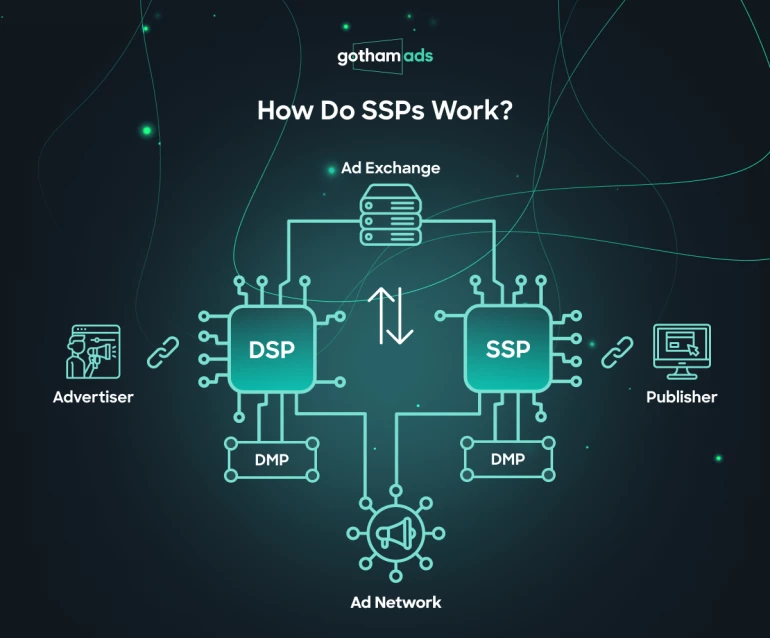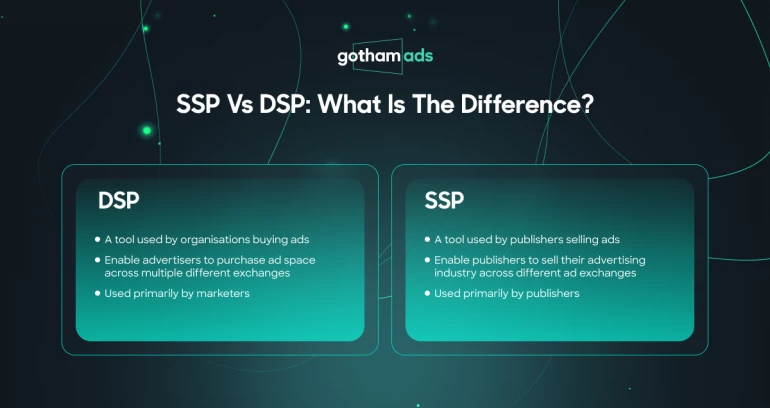SSP Programmatic: What You Should Know

To truly understand programmatic advertising, it’s important to get to know one of its key components: a supply-side platform (SSP).
SSP is programmatic software for publishers to facilitate sales of their advertising impressions. It offers unparalleled opportunities for web publishers and app developers that are willing to maximize advertising revenues directly. The SSP ecosystem brings together a wide array of demand sources and supply partners, each expanding the opportunities for media trading.
How Do SSPs Work?
Supply-Side Platforms (SSPs) connect publishers with multiple demand sources simultaneously in a programmatic marketplace. After configuring their campaign settings, the selling process becomes automated through programmatic or real-time bidding.

There is a lot of in-depth information as to how SSPs work in practice. Here’s a brief overview of it:
1. Publisher integration. Publishers integrate their digital properties, such as websites or mobile apps, with an SSP. This involves configuring their ad inventory in the SSP’s system, including specifying ad sizes, formats, and locations on their sites or apps.
2. Inventory management. Publishers use the SSP to set parameters for their ad inventory, including floor prices (minimum acceptable bid amounts), types of acceptable ads, and any specific advertiser preferences or blocks. This helps ensure that the ads displayed are in line with the publisher's content and audience expectations.
3. Connecting to demand. The SSP connects to various demand sources, including Demand-Side Platforms (DSPs), ad exchanges, and sometimes directly to advertisers. This broad connection increases the potential demand for the publisher's ad inventory.
4. Bid request. When a user visits a publisher’s site or app, the SSP automatically sends out a bid request to potential advertisers through the connected DSPs and ad exchanges. This request includes details about the available ad space and anonymized user data, like demographics, interests, and browsing behavior.
5. Auction process. Advertisers interested in the ad space respond to the bid request by submitting bids in real time through their DSPs. Each bid reflects the value of the ad impression to the advertiser, based on the user’s profile and the ad space characteristics.
After that SSP evaluates all received bids against the publisher’s set parameters, including the floor price. The highest bidder that meets these criteria wins the ad impression.
6. Ad delivery. Once a winning bid is selected, the SSP facilitates the delivery of the advertiser’s ad to the user’s device. This entire process, from bid request to ad display, happens in milliseconds, ensuring a seamless user experience.
7. Reporting and optimization. The SSP provides publishers with detailed reports on ad performance, including metrics like fill rate, revenue, and CPM (cost per thousand impressions). Publishers can use this data to adjust their inventory settings and strategies for better performance.
What Are the Main Components of an SSP?
At the heart of an SSP are several core components that work in harmony to facilitate the seamless sale of ad space to advertisers in real-time. Understanding these components provides insight into how SSPs optimize ad revenue for publishers while maintaining control and quality over the advertisements displayed.
1. Backend and infrastructure. The backend and infrastructure of SSP form the technological foundation that enables all of its operations, from managing ad inventory to executing RTB auctions. This component is crucial for ensuring the scalability, reliability, and performance of the SSP.
2. Integrations. SSPs integrate with other AdTech platforms to facilitate the selling of inventory and with data-management platforms to maximize their revenue.
3. Ad Exchange. Ad exchanges are integral to the SSP ecosystem, as they connect SSPs (representing publishers) with Demand-Side Platforms (DSPs) (representing advertisers). This connection ensures a wide reach for publishers' inventory, increasing the competition and potential revenue. Ad exchanges are where the actual auctioning of ad spaces takes place, making them a central piece of the programmatic advertising puzzle.
4. Trackers. Trackers are critical tools within SSPs that monitor and analyze the performance of advertisements. They collect data on numerous metrics, such as impressions, clicks, conversions, and user engagement. This information is vital for publishers and advertisers alike, as it provides insights into the effectiveness of ad campaigns and the overall performance of the ad inventory. Trackers enable publishers to optimize their ad spaces based on real-time data, ensuring that they can maximize revenue while providing valuable feedback to advertisers on campaign success.
5. Reporting database. The reporting database receives campaign and audience data from the tracker, which allows publishers to generate reports and view campaign analytics.

SSP vs DSP: What is the Difference?

SSPs and DSPs serve different roles in the programmatic advertising ecosystem.
SSPs enable publishers to organize and optimize their ad space across various digital channels, such as websites, mobile apps, and connected devices. By using this tool, publishers can maximize their revenue by connecting with multiple demand sources, including DSPs and ad networks.
It is also important to note that SSPs employ sophisticated algorithms to analyze available demand and determine the best price for each impression. This ensures that publishers receive the highest possible revenue for their inventory.
At the same time, DSPs empower advertisers to target and deliver their ads to the right audience. Advertisers and agencies use DSPs to manage and optimize their digital advertising campaigns. DSPs allow advertisers to target specific audiences based on various parameters, such as demographics, interests, and behavior. They enable precise audience segmentation and targeting for effective campaign delivery.
Moreover, DSPs participate in real-time auctions conducted by SSPs and ad exchanges to bid on available ad impressions. This participation allows advertisers to compete for ad placements that match their targeting criteria. By integrating with multiple ad exchanges, SSPs, and other supply sources, DSPs access a wide range of ad inventory. This enables advertisers to reach their target audience across various publishers and platforms.
Together, SSPs and DSPs facilitate the buying and selling of ad inventory in real-time, allowing publishers to maximize revenue and advertisers to achieve their marketing objectives.
What Should Publishers Look for in an SSP?
There are many ways to monetize website traffic, but advertising can generate the highest income, especially if your traffic is substantial and consistent. There are several important features to consider when choosing an SSP.
Multiple sources of demand
An SSP must be connected to as many demand-side platforms and ad exchanges along with ad networks as possible. This maximizes reach meaning that impressions can potentially be served to more viewers.
Transparency
SSP dashboard should provide information across all metrics that matter. For instance, the click-through rate (CTR) and the total number of clicks placement generates, fill rates, and so on. It helps publishers to understand the true value of their digital inventory.
RTB capabilities
Look for an SSP that offers robust RTB technology, enabling you to sell ad inventory in real-time to the highest bidder, maximizing revenue.
Ad format support
Ensure the SSP supports a variety of ad formats (such as display, video, mobile, native) to maximize your monetization opportunities across different types of content.
Brand safety and control
The platform should offer comprehensive tools for brand safety, allowing you to filter out undesirable advertisers and ensure the ads displayed are appropriate for your audience.
Dynamic price floors
Publishers must establish “hard” and “soft” price floors and define a minimum acceptable cost per thousand impressions (CPM). It keeps pricing flexible enough to sell out remnant inventory to the last piece. Still, it protects the publisher from potentially disadvantageous deals because deals below a defined price threshold (price floor) won’t be allowed by the system.
Integration capabilities
The SSP should easily integrate with other ad tech platforms you use, such as ad servers, DSPs, and data management platforms (DMPs), for seamless operation.
What Features Does GothamAds SSP Offer?
GothamAds SSP offers a suite of advantages designed to empower publishers to maximize their ad revenue, streamline their operations, and access a global marketplace of premium advertisers. Here are some key benefits:
Premium demand
With GothamAds, publishers can connect with premium advertisers worldwide and monetize their inventory automatically.
Strong campaign controls
As a publisher, you are the one who determines the look and feels of ads on your site or in app. Control price floors, placements, and who to trade with yourself in the publisher's dashboard.
Revenue maximization
Mediation algorithms constantly optimize campaign outcomes. As well, the platform increases performance and improves Fillrate, eCPM, and publisher's yield as a result.
Safe in-app experience
Enhanced brand safety for mobile publishers is enabled by the strongest anti-fraud tools and traffic verification teams.
Enhance the monetization of your website or app using the advanced supply-side platform offered by GothamAds.


